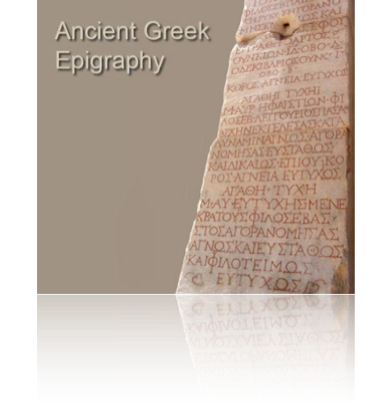

Greek Epigraphy

What is Epigraphy?
Epigraphy is the study of inscriptions, and more specifically, the deciphering of ancient inscriptions. Several resources related to the study of ancient Greek epigraphy are available on the web and can be reached through this page.
For a thorough discussion of the epigraphic evidence dating from the Hellenistic-Roman period, see Bradley H. McLean, An Introduction to Greek Epigraphy of the Hellenistic and Roman Periods from Alexander the Great down to the Reign of Constantine 323 B.C. - A.D. 337. For a discussion of the wider question of the nature of epigraphy and its role in the judgments of historians, see A. Geoffrey Woodhead, The Study of Greek Inscriptions.
Organizations
Numerous organizations maintain websites providing information on their own epigraphical work or offering brief descriptions of work with inscriptions done by others. Some provide images of significant inscriptions.
- The American Society of Greek and Latin Epigraphy, associated with L’Association Internationale d’Epigraphie grecque et latine
- The British Epigraphy Society, an independent 'chapter' of L’Association Internationale d'Epigraphie grecque et latine
- Center for Epigraphical and Palaeographical Studies, Ohio State University
- Centre for the Study of Ancient Documents, Oxford University
- Epigraphic Database Heidelberg, Heidelberg Academy of Sciences and Humanities
- Packard Humanities Institute Greek Epigraphy Project (Searchable inscriptions!), A Project of Cornell University and Ohio State University
- Inscriptiones Graecae, Berlin-Brandenburgishe Akademie der Wissenschaften
- Program in Aegean Scripts and Prehistory, University of Texas at Austin
- The Sara B. Ailshire Center for the Study of Ancient Greek Epigraphy, University of California, Berkley
- The U.S. Epigraphy Project, Greek and Latin Inscriptions in the USA
Images and Collections
The list below provides direct access to a number of image collections. These collections are developed and maintained by some of the organizations listed above. By placing their images on the internet they have made them available to a worldwide network of scholars interested in ancient Greek epigraphy. They deserve our sincerest gratitude.
- Aphrodisias in Late Antiquity
This site presents the electronic second edition of Aphrodisias in Late Antiquity: The Late Roman and Byzantine Inscriptions, by Charlotte Roueché, King's College London, expanded and revised from the version published by the Society for the Promotion of Roman Studies in 1989. Several Greek inscriptions are included in this electronic edition.
- J.M.R. Cormack Macedonian Collection (Squeezes)
A large collection of inscriptions from Macedonia.
-
The web site of the Center for Epigraphical and Paleographical Studies at Ohio State University contains a list of scanned images of dated Attic inscriptions. Each listing serves as a link to an image of the relevant squeeze and is accompanied by information listing publication(s) where a copy of the text can be found including the most recent publication from which a bibliography for the inscription can be obtained. Each image also serves as a link to a larger version of the same squeeze. A 2 cm scale has been scanned in with each squeeze (most are approximately twice actual size).
- Inscriptions of Israel/Palestine Project (http://www.stg.brown.edu/projects/Inscriptions/)
The “Inscriptions of Israel/Palestine” project at Brown University seeks to collect and make accessible over the Web all of the previously published inscriptions (and their English translations) of Israel/Palestine from the Persian period through the Islamic conquest (ca. 500 BCE - 640 CE). There are about 15,000 of these inscriptions, written primarily in Hebrew, Aramaic, Greek and Latin.
- Mysteries at Eleusis: Images of Inscriptions
Cornell University Library has in its digital collection a large number of high quality photographs of inscriptions from Eleusis. You can even download copies of the pictures!
Books on Ancient Greek Epigraphy
While many books on epigraphy are available, the following are influential and provide specific discussion of ancient Greek inscriptions. Any of them would make a good starting place for your study.
Bradley McLean, An Introduction to Greek Epigraphy of the Hellenistic and Roman Periods from Alexander the Great down to the Reign of Constantine 323 B.C. - A.D. 337. University of Michigan Press, 2011.
B. H. McLean discusses the classification of inscriptions and analyzes particular classes of inscriptions, including decrees, honorary inscriptions, dedications, funerary inscriptions, and manumission inscriptions. The book also discusses special topics relevant to the interpretation of specific inscriptions, such as Greek and Roman administrative titles and functions.
John P. Bodel, Epigraphic Evidence: Ancient History From Inscriptions, Approaching the Ancient World. Routledge, 2001
John P. Bodel provides a solid introduction to what inscriptions can reveal about ancient life in the Greco-Roman world. Epigraphic Evidence offers a useful, readable account of the vast diversity of inscriptional remains from this period as well as the difficulties faced by historians who must rely on such evidence.
A. Geoffrey Woodhead, The Study of Greek Inscriptions. Cambridge University Press, 1967.
This is considered by many to be the standard introduction to the field for readers in English. Besides a solid coverage of the major aspects of the discipline, this second edition provides a guide to the major corpora of published Greek inscriptions.
Professor Woodhead passed away on November 6, 2008. He will be missed, and his contribution to the field long remembered.
Craig Cooper. Epigraphy and the Greek Historian. Phoenix Supplementary Volumes, 47. University of Toronto Press, 2008.
This collection of essays is divided into two sections: one covering Athens, and the other covering the wider hellenistic world. The collection illustrates well the way analysis of individual inscriptions informs the work of historians.
Discussion List
INSCRIPTIONES-L is a moderated scholarly discussion list devoted to the study of Classical Epigraphy. Its purpose is to provide a forum for all aspects of such study. While the primary focus of the list is the discussion of inscriptions from the Greek and Roman worlds, discussion of inscriptions from 'peripheral cultures' is also welcome.